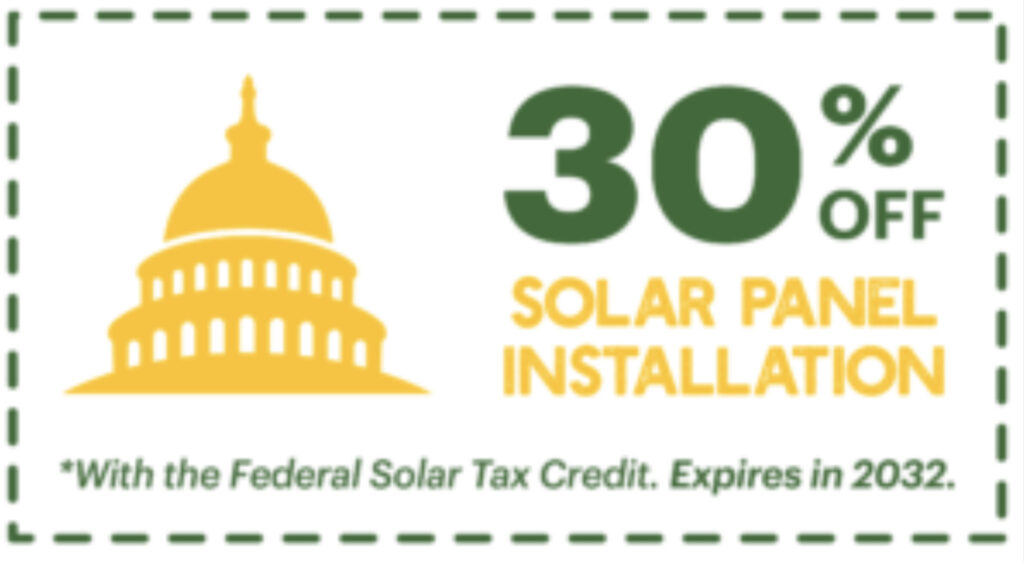
Solar energy can save you money on your electricity bills and reduce your carbon footprint, but it usually comes with a high up-front cost. Fortunately, the U.S. government offers a federal solar tax credit, which was recently extended in the Inflation Reduction Act, to help reduce this cost and make the transition to solar more affordable.
The federal solar tax credit, also known as the solar Investment Tax Credit (ITC), allows you to receive a deduction on your federal taxes equal to 30% of your solar panel installation costs for the cost of installing a solar panel system. The policy was introduced as part of the Energy Policy Act of 2005 and was initially set to expire in 2007. However, Congress has extended the policy multiple times, giving homeowners more time to take advantage of the deduction.
Although the policy has remained the same since its introduction, rate has fluctuated. It was set at 30% from 2016 to 2019, but reduced to 26% in 2020 and was set to remain at that rate for the remainder of 2022.
In August 2022, Congress passed the Inflation Reduction Act which included an extension of the ITC. Homeowners can now claim a 30% tax credit for 2022 installations. The 30% credit is available through 2032. The ITC will drop to 26% in 2033 before reducing to 22% in 2034. It will end in 2035 unless Congress renews it again.
Starting on Jan. 1, 2023, you can also claim the 30% credit for stand-alone solar batteries with a minimum of 3 kilowatt-hours (kWh) of capacity. The battery does not have to be directly tied to a solar panel system to qualify.
The ITC is available for solar customers throughout the United States. However, the federal government outlines specific qualifications that must be met to take advantage of the tax credit. Before applying for the solar investment tax credit, make sure you meet these qualifications.
New Solar Power System Installed During a Qualifying Tax Year.
You must have your solar panel installation completed within the qualifying time period. For example, your system must have been in place by Dec. 31, 2022 to qualify for the 30% deduction on your 2022 taxes. Homeowners have until Dec. 31, 2032 to receive the 30% tax credit. Otherwise, you will receive 26% in 2023 and 22% in 2034.
The system must also be new or being used for the first time during the specific tax year. You cannot qualify for the deduction with a pre-owned solar system. For example, if you purchased a home with a pre-installed solar energy system, you’re not eligible for the ITC.
Solar power companies typically offer up to four financing choices: full price purchase, loan, lease, or power purchase agreement (PPA). Homeowners have complete ownership of the solar project if they purchase at full price or take out a loan. However, if you choose to lease your system or agree to a PPA, the solar company retains ownership of the solar system.
You must own your solar system to qualify for the federal solar tax credit. Make sure to choose either the up-front purchase or solar loan if you want to take advantage of this incentive.
The solar equipment must be used at either your primary residence or secondary home in the United States. The following types of homes qualify for the deduction:
Rental properties cannot be claimed for the ITC unless you live there for part of the year and rent out the property whenever you aren’t residing there. However, you can only claim the credit for the amount of time that you live at the property. For example, if you only live at the rental property for six months, you qualify for 50% of the deduction (equivalent to six out of 12 months) versus a 100% deduction (equal to 12 out of 12 months).
The ITC applies to the total cost of the energy-efficient equipment, the cost of labor, and any additional equipment that supports the system. The following equipment meets the eligibility requirements:
Solar photovoltaic (PV) panels or PV cells
Labor costs for the preparation and installation of your solar PV system, including permits, developer, and inspection fees
Solar storage devices that are charged by the PV system (stand-alone batteries qualify after Dec. 31, 2022)
Additional equipment that supports the solar system, including mounting equipment, inverters, and wiring
Sales taxes on qualified expenses (when applicable)
Only 25 states offer sales tax exemptions for purchasing a solar panel system, so this may not apply to you. Check your state’s solar policies to verify.
Homeowners will need the necessary tax forms to receive the ITC. The Internal Revenue Service provides detailed instructions for completing the tax form on its website. Below is a general overview of the steps to file*:
Use IRS Form 5695 when you file your federal tax returns.
You will complete Part 1 of the form to calculate your renewable energy tax credit. Keep your receipts for your solar system project and enter the information accurately.
Enter the amount of your tax deduction on your 1040 form.
Remember that the ITC is a tax credit, not a tax refund. The difference is that a tax refund is paid out to the taxpayer, but a tax credit reduces the amount of taxes owed. If your tax liability for the year is less than the ITC, the Internal Revenue Service will not refund you for the tax deduction. Instead, the deduction will roll over to the next tax year.
*We are not a professional tax service provider or preparer. All information provided is for educational purposes only. Please consult a tax professional for tax advice about your federal income tax preparation. You can also contact the Internal Revenue Service directly for any additional information.
Residential energy customers may be intimidated by the cost of going solar, but the federal solar tax credit helps offset some expenses. This tax credit, along with other solar incentives, credits, and rebates, makes the process as affordable as possible.
Since the ITC has an expiration date, new solar energy customers should take advantage of the tax credit soon. If you are a homeowner looking to go solar, we suggest finding the best solar power companies in your area to start the process before the ITC deadline.

You can only claim the ITC once on your tax return. However, any unused credits will carry over to the next tax year. For example, if you received $7,000 in solar tax credits but your tax liability was $6,500, you would pay $0 for your owed taxes. Then, the remaining $500 would roll over to the next tax year.
Yes, the federal tax credit was extended in August 2022 as part of the Inflation Reduction Act. The credit increased from 26% to 30% for solar panel systems installed in 2022. The 30% deduction is available until 2032. The credit will reduce to 26% in 2033 before dropping to 22% in 2034. The tax credit will end in 2035 unless Congress extends it again.
You can claim the tax credit if the solar panels are new and the builder has not already claimed the credit. If you buy a resale home with pre-owned panels already installed, you cannot claim the tax credit. Qualifying solar panel installations must be new or being used for the first time.
The federal solar tax credit is based on the gross system cost of your solar power system. Homeowners who install a system in 2022 can apply a tax credit equal to 30% of their installation costs to their taxes for the following year. For example, you’ll receive $6,000 if you spend $20,000 on a solar system installed in 2022.
You can claim the solar tax credit once. Unused credit that cannot be applied to your tax liability for the current year can roll over to the next tax year.
Yes, income from solar panels is treated the same as other income and is taxable.